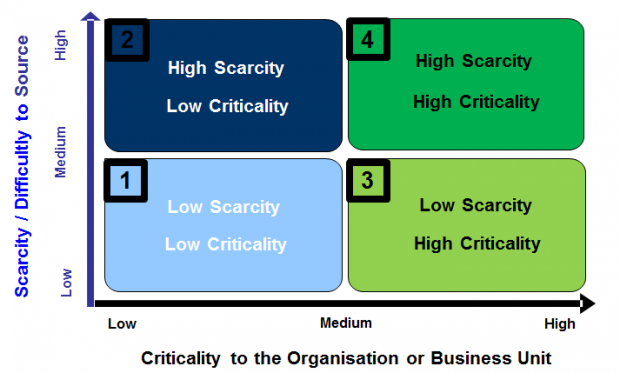The SCIENCE “systematic approach to identifying the best strategies and tools to uncover talent, measure, and refine the process”
The ART “difficult to measure, involves talent pipeline activities, and relationship building”
I have seen many recruitment functions create a sourcing team with good intentions. However, these teams can often get hijacked by recruiters, hiring managers, or part of the business with greater influence, to work on jobs that may not the most important jobs within the organization.
Not All Jobs are Created Equal
It’s a fact that some jobs are more important that others. But how can you have a fair and just process in place to determine your sourcing focus?
It’s best to have the sourcing function or sourcers report to a central manager (such as Recruitment Manager or Sourcing Manager) to ensure sourcing work is not hijacked and a non bias decision is made that’s best for the business.
In my experience, one issue that always comes up is that every hiring manager thinks their job is the most important, when in reality, some jobs are more important than others. So how do you get past this situation and gain agreement from all stakeholders?
Engage All Stakeholders in the Decision
First, agree with all key stakeholders on a criteria for what defines a job the sourcing team should be focused on and stick too it!.
I would consider the following three factors.
Criticality – How critical is this job to the business?
To do this you should define 5 – 7 key statements defining criticality and a scoring framework (keep it simple e.g. 5 = High, 3 =Medium and 1 = Low).
Some things to consider when defining criticality statements (and you need to be specific as possible) would be:
- The job is directly related to revenue generation?
- The job is directly related to product innovation?
- The job is directly related to key client relationship management?
- The job is directly related to key projects
- The job is directly related to company growth strategies
And so on….
Scarcity – how difficult is it to recruit for this job
As above, use 5 – 7 statements that define scarcity and a simple scoring framework.
Some things to consider when defining scarcity statements:
- Is this skill available in the local market?
- Do you need to go offshore to source this job?
- When you have recruited this job in the past how long did it take to identify the right candidate? For example it’s taken 45+ days to source then it should be considered scarce.
- Is this a new skill set we need to recruit?
- Is this skill easy to source?
And so on…
Volume = how many do we need to recruit
This is important as it will assist you how you allocate the sourcing teams time. For example if you only need to recruit 1 vs. 5 of a particular skill then that may determine how you prioritise the sourcing efforts and maybe even outsource or delaying sourcing.

Plot the Focus
Once you defined the above statements you can validate each job against each statement and allocate an appropriate score for criticality and scarcity.
Ideally plot each job on an X & Y axis (Criticality & Scarcity), the jobs that sit in quadrant 4 is where the sourcing team should focus as they are the most critical to the business and a scarce to recruit.
Quadrant 3 the sourcing team could also work on these if they have capacity.
If they fit in quadrants 1 and 2 probably should be outsourced or worked on at a later date when the sourcing team has capacity.
If you have limited resources then this will assist managing your sourcing efforts and focused on what’s most critical to the business.
Applying this approach will ensure your sourcing efforts are focused in areas with the greatest impact on the business.
Happy sourcing!
